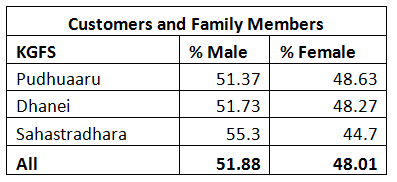(This is the first of a series of posts titled “Understanding the KGFS Customer”. The authors will attempt to understand the lives of enrolled customers of Kshetriya Gramin Financial Services (KGFS) by exploring the datasets in the Customer Management System (CMS) being used at KGFS. This data is collected during customer enrolment process and gets updated periodically. The introductory post carries work done by Abigail Andrews, pursuing her graduation in Economics at Stanford University, as part of her internship with IFMR Rural Finance.)
This blog post displays basic demographic data of all enrolled members of the three KGFSs, Pudhuaaru (Tamil Nadu), Dhanei (Orissa) and Sahastradhara (Uttarakhand). The analysis below is a first step in an effort to comprehensively understand the KGFS customer, and characterize their households across the three existing KGFS operations.
Note:
- “Customers” in this blog post signifies the individuals in a household who physically completed the enrollment process with a Wealth Manager, in a KGFS branch.
- “Family Members” refers to the remaining members of the enrolled household.
- Taken together, each household enrolled with KGFS has at least one customer and, usually, a number of additional family members.
- All analysis is using data captured as of July 31st, 2011, and unless otherwise noted all time-related variables are calculated as of August 1st, 2011.
- Each variable was compared across the three KGFS operations, which operate in geographically and economically distinct regions.



The dependency ratio reflects the number of non-income earning family members (characterized as “dependents”) divided by the total number of family members in a household.







The gender distribution of KGFS customers varies across the 50/50 line between Pudhuaaru and Dhanei / Sahastradhara. Because there are significantly more male than female family members in all three operations, the gender ratios for family members younger than 15 years of age, was also analyzed.



The vast majority of KGFS customers are married, and amongst the small percentage of customers that are single, most are male.






The graph below illustrates the gender differential in education levels, highlighting Dhanei and Sahastradhara females as the least educated populations served by KGFS.

In order to capture the frequency of education levels above 12th standard in the dataset, a variable for “higher education” was created. This variable indicates an education level of “Vocational Course,” “Graduate,” or “Post Graduate.”

The data within this blog post provides a basic demographic snapshot of the KGFS customer base as it stands today, according to the data captured during the enrollment process. Even within these simple demographic variables, the data shows substantial variation between the three KGFS operations. Through further analysis, these variations alone could lead to significant and exciting insights for the KGFS model.


One Response
In one word, it is just ‘EXCELLENT’. It would help future researchers on this great work of IFMR to get more accurate and reliable data. In most of the projects, the type of data provided by ur blog is missing as they were maintaing legacy system of capturing and analysing the data. In that respect, technology has enabled this to happen. It is also the human resource and the thinking thro process at the helms of affairs of IFMR has made it possible.